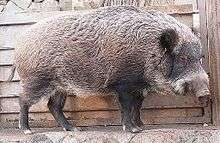Japanese boar
The Japanese boar (Sus scrofa leucomystax), also known as the white-moustached pig,[2] inoshishi (イノシシ),[3] or yama kujira (山鯨, lit. "mountain whale"),[3] is a subspecies of wild boar native to all of Japan, save for Hokkaido and the Ryukyu Islands.
| Japanese boar | |
|---|---|
 | |
| S. s. leucomystax, Tama zoo | |
| Scientific classification | |
| Kingdom: | Animalia |
| Phylum: | Chordata |
| Class: | Mammalia |
| Order: | Artiodactyla |
| Family: | Suidae |
| Genus: | Sus |
| Species: | |
| Subspecies: | S. s. leucomystax |
| Trinomial name | |
| Sus scrofa leucomystax Temminck, 1842 | |
| Synonyms[1] | |
|
Species synonymy
| |
Taxonomy
It is a small, almost maneless, yellowish-brown subspecies[4] with distinctive white whiskers extending from the corners of the mouth to the cheeks.[2]
Culture
It features prominently in Japanese culture, where it is widely seen as a fearsome and reckless animal, to the point that several words and expressions in Japanese referring to recklessness include references to boars. The boar is the last animal of the oriental zodiac, with people born during the year of the Pig being said to embody the boar-like traits of determination and impetuosity. Among Japanese hunters, the boar's courage and defiance is a source of admiration, and hunters and mountain people not uncommonly name their sons after the animal.
Boars are also seen as symbols of fertility and prosperity; in some regions, boars are thought to be drawn to fields owned by families including pregnant women, and hunters with pregnant wives are thought to have greater chances of success when boar hunting. The animal's link to prosperity was illustrated by its inclusion on the ¥10 note during the Meiji period, and it was once believed that a man could become wealthy by keeping a clump of boar hair in his wallet.[5]
It is a popular subject among netsuke sculptors, and is mentioned in Kojiki (711-712), the oldest extant Japanese chronicle. The boar also features in Japanese poetry, having first appeared in the works of Yamabe no Akahito.[3] Its importance in the Japanese diet was such that it was exempt from Emperor Tenmu's ban on meat-eating in 675.[6]
References
- Wozencraft, W.C. (2005). "Order Carnivora". In Wilson, D.E.; Reeder, D.M (eds.). Mammal Species of the World: A Taxonomic and Geographic Reference (3rd ed.). Johns Hopkins University Press. pp. 532–628. ISBN 978-0-8018-8221-0. OCLC 62265494.
- von Siebold, P. F. (1842), Fauna japonica sive Descriptio animalium qu, in itinere per japoniam suspecto annis 1823-1830, Volume 1, Müller, pp. 57-58
- Garis, Frederic de & Sakai, Atsuharu (2013), We Japanese, Routledge, p. 106, ISBN 1136183671
- Groves, C. (2008). Current views on the taxonomy and zoogeography of the genus Sus. pp. 15–29 in Albarella, U., Dobney, K, Ervynck, A. & Rowley-Conwy, P. Eds. (2008). Pigs and Humans: 10,000 Years of Interaction. Oxford University Press. ISBN 978-0-19-920704-6
- Knight, J. (2003), Waiting for Wolves in Japan: An Anthropological Study of People-wildlife Relations, Oxford University Press, pp. 49-73, ISBN 0199255180
- Ishige, Naomichi (2014), History Of Japanese Food, Routledge, pp. 53-54, ISBN 1136602550
External links
